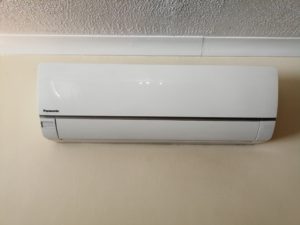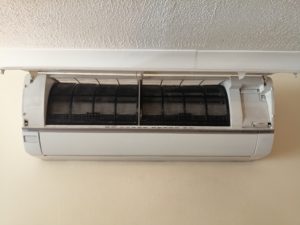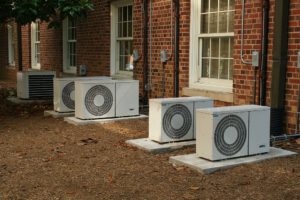Air Conditioning Units
Overview
Air conditioning units are heat pumps which were traditionally used for cooling only, however in more recent years, it has become common for air conditioning units to perform both heating and cooling functions.
As well as heating and cooling, air conditioning systems will help to manage humidity, and to remove dust and pollen from the air.

Types of Air Conditioning Unit
Through the Window Air Conditioners
At the bottom of the market are free-standing through the window air conditioning units designed for occasional use during heat waves. These units have appalling energy efficiency, and are only used for cooling. Not only are they made very cheaply with low quality components, and have motors without variable speed control – so the motor runs inefficiently, but they also require that a window be kept open in the room being cooled. As there is an open window, during heatwave conditions, hot air can re-enter the room through the window almost as fast as it is removed by the air conditioning unit. With this kind of through the window air conditioner, warm air is blown out through a large pipe similar to those used on non-condenser tumble driers. Typically, these units are also noisy, and may not last very long as their components are far from the finest. The one advantage they have is that they come as a single unit and do not require professional installation.
Such units may well have a coefficient of performance (COP) of around 2 to 2.5, however given the losses through heat coming back into the room through open windows (especially if South facing), their effective performance can be a lot less.
There is also a slightly better built version of this type unit designed to permanently mount on a wall discharging through a pipe through the wall or through a plastic panel as is sometimes found in the bottom half of a window frame. These at least lessen the back leakage of heat as they do not require an open window. These units again are in the form of a single unit, however as they are permanently installed they would need to be wired in by an electrician. No need for an F Gas engineer as the refrigerant gas is factory installed and sealed in the unit. Such units are no longer in common use since more efficient split air conditioning units are now fairly affordable.
Ducted Air Conditioning Units
Ducted air conditioning systems were traditionally used in commercial buildings and have only an external air conditioning unit and ducted air with controlled vents – air is heated or cooled at the exterior unit then blown through ducts in the building to interior vents. There are 2 sources of high energy usage in these systems firstly the significant amount of power required to drive air through extensive duct networks to the vents, and second the large surface area of the ducting system which results in a large amount of losses of the heating or cooling effect by the normal heat loss / gain mechanisms of conduction, convection and radiation before the pumped air even reaches the room it is meant to heat or cool.


Split Air Conditioning Units
Split air conditioning units are made up of 2 parts, a larger external unit and a smaller internal unit. The external unit does all the hard work, and is where most noise is created – removing most noise from the room being cooled. The external unit houses the compressor, condenser coil, and either expansion coil or capillary tubing whilst the indoor unit houses a cooling coil, a blower, and an air filter. The two are connected together by a small diameter pipe through which refrigerant gas flows and by electrical wires. There is no need for a powerful fan, or for an extensive duct network substantially saving on installation costs, and eliminating both fan energy consumption, and losses of heat or cool through imperfectly insulated ducts. The small size of the refrigerant gas pipe greatly reduces the potential for heat / cooling losses and allows for easier installation of decent insulation.
Some split air conditioning units are reversible in which case the indoor unit's coil serves for either heating or cooling.
In some split systems known as split multi, a single external unit can be linked to several internal units saving on hardware and installation costs.

For help and advice Free Phone 0800 298 5424
General Advice
Split air conditioning units must by law be installed and if needed recharged by F Gas qualified personnel. They will also need to be installed by a qualified electrician - usually F Gas engineers also have the electrician qualification, so often will not need 2 people for the installation.
As with any electrical item designed to deliver long term service, you tend to get what you pay for. It is recommended to use high efficiency products with long warranty from well known producers.
Do not be tempted by cheap products with short warranties as you will probably end up with less efficient products which cost a lot to run, and need replacing after a few years. With quality products with variable speed drive, energy consumption is usually lower, and if correctly specified and well maintained will typically last around 20 years.
Consider also that installation is a significant part of the total cost, and that installing cheap units twice costs considerably more than installing a decent product once.
Inverter Controlled – Variable Speed Drive
The efficiency of an air conditioning unit can be significantly influenced by whether or not it uses an inverter controlled variable speed drive. Inverter controlled units are typically around 30% more efficient than units without such controls, and in addition, typically put a lot less stress on the motor (The extra 30% electricity consumption of compressors without a variable speed drive converts to heat in the motor driving the compressor – which in the typical fashion of all electronics deteriorates more the hotter the electronics become).
Consider also that installation is a significant part of the total cost, and that installing cheap units twice costs considerably more than installing a decent product once.
Other Factors Affecting Efficiency
A number of variables can significantly influence the efficiency of an air conditioning unit – factors specific to the unit such as the quality and design of the compressor unit and fan, the size of the condenser and expansion coil relative to its rated output (bigger is usually more efficient), the spacing of the heat exchanger vanes (Larger spacing results in less need for defrost cycles when operating in heating mode), the refrigerant gas used in the unit and the unit's settings at the time. Units with VSC tend to operate at a higher COP at part load than full load as the coils do not need to generate as big a temperature change to deliver the required heating or cooling.
As well as equipment related factors, weather conditions, altitude, and climate zone can significantly impact efficiency. If you are heating in a cool humid zone, and the outdoor temperature is 4 centigrade with fog, then taking heat from the outside air will readily cause frost to form on the external heat exchanger, and the heat exchanger vanes if close spaced can quickly clog with ice impairing the unit’s efficiency. When this happens, periodic heating of the heat exchanger will be required to shed the ice. On the other hand, in a desert at similar temperatures with dry air, far less ice will form, and efficiency with a 4 centigrade outside temperature will be a good deal better. As a result of both the defrost cycle, and latent heat in the water content of humid air, a larger capacity unit will be required to reliably deliver a given temperature change in a humid region than in one with dry desert air. At altitude the same need for a slightly bigger unit applies as thin air does not supply or dissipate as much heat as denser sea level air.
If installing the units primarily as heaters, then it is best if possible to site the external unit/s on the South side (Northern Hemisphere locations) of the building as when the sun shines, the air on that side of the building will be warmer than on the North, so making the heating more efficient.
(The smaller the temperature difference between the room being heated or cooled, and the outside air the more efficiently a heat pump will run)
It is important to use units suitable for your climate zone, as typical units will allow you to use the unit for heating down to an outdoor temperature of -15 centigrade whilst a few are designed for colder temperatures down to – 25 centigrade. Pick a – 15 centigrade unit for heating in central Sweden, and just when you need heat most with the outside temperature at – 20 centigrade, it will fail to deliver any heat. Similarly, there may be an upper temperature above which a unit is not designed to cool. This being the case, you would use a different unit for heating in the Scottish Highlands or Sweden than you would use for cooling in the UAE.
Whilst a basic and a high quality unit might have nominally similar COP (similar expected energy consumption for a given delivery of heating or cooling under standard test conditions), it is quite possible that outside of those standard test conditions – when temperatures are very high or low, or where conditions are cool and humid resulting in icing of the coils in the exterior unit that the basic unit will underperform whilst the quality unit continues to perform well. It should be noted that COP under extreme conditions falls away compared to standard test conditions, and that the unit will need to perform adequately even in the most extreme expected conditions. This being the case, it is best to size the unit to meet the maximum heating or cooling requirements of the room under the most demanding weather conditions.
Measures of Performance
Coefficient of Performance (COP)
This is a measure of how many times more heating or cooling is delivered per kWh of electricity used under standard conditions
e.g. A split air conditioning unit might deliver 4 kWh of heating for 1 kWh of electricity used with the outdoor temperature at 7 centigrade, and the room at 20 centigrade.
Seasonal Energy Efficiency Ratio (SEER)
Unlike COP which measures energy efficiency under standard conditions, SEER is a weighted ratio of the energy efficiency of air conditioning units averaged over the heating or cooling season, and with specific proportions of usage assumed to be at 25%, 50%, 75%, and 100% loading.
Whilst the COP will be fixed for any given unit under standard conditions, the SEER will vary by country and region taking into account the climate of the country or region.
European Seasonal Energy Efficiency Ratio (ESEER)
Very similar to SEER but with different weightings for different levels of load.
Maintenance
Some maintenance tasks can be carried out by the user.
Clean or replace your filters at least once a month following the manufacturer’s instructions during heating and cooling seasons so they don't get clogged with dust. Note that clogged filters can result in a 20% increase in energy consumption. You can also pass a vacuum cleaner or duster over the coil and condenser of the exterior unit as well as the heat exchanger of the interior unit. Do not engage in any maintenance activity beyond cleaning. Consider getting a professional in for an annual check-up / service.
If your unit begins to lose performance, and fails to deliver the heating or cooling you expect, it may need to be recharged with refrigerant gas. This task by law MUST be performed by an F Gas registered engineer.
Refrigerant Gases
Until fairly recently, most air conditioning units were running on refrigerant gas R410a – which replaced earlier Chlorofluorocarbons CFCs banned under the Montreal Protocol which went into effect at the beginning of 1989 to protect the Ozone Layer. As well as destroying Ozone in the Antarctic region, CFCs were powerful greenhouse gases.
R410a is a Hydrofluorocarbon and was used as an interim compromise until better alternatives could be developed, whilst protecting the Ozone layer as it does not destroy Ozone, R410a still has a significant greenhouse potential 2090 times as high as an equivalent amount of CO2 so leakage is to be avoided wherever possible.
Current state of the art air conditioning units (the most recent models) use R32 which is Ozone safe, and has only 1/3 the greenhouse gas potential of R410a at 675 times the warming potential of CO2. Its use also allows for around a 10% reduction in electricity consumption.
For the future, it is possible that systems will go over to using CO2 as a refrigerant as it has zero Ozone destruction capability and can be sourced as a by-product from many processes, or obtained from the atmosphere. CO2 has a warming potential of 1. CO2 heat pumps are more expensive than those using R410a or R32, but they do have good real world efficiency. CO2 requires compression to 7 to 10 times higher pressures than older refrigerant gases to operate efficiently placing significantly greater technical demands on the hardware so costing a bit more. As a result of this higher cost CO2 tends to be used for larger industrial heat pumps where the extra hardware cost is “dilute” across a larger load. It is also now being used in some vehicle air conditioning systems.
Other interesting articles:
Click on the links below for further information:
Independent Chartered Surveyors
If you want an independent expert opinion from a chartered building surveyor Free Phone 0800 298 5424. We carry out valuations, building surveys, structural surveys, structural reports, engineers reports, specific defects reports, home buyers reports or any other property matters.
We feel our surveys are quite unique, as they are written to your level of knowledge. The surveys include photos and sketches and definitions. The survey will also include an action required section and an estimate of costs in the executive summary. We are more than happy to meet you at the property whilst carrying out the survey to discuss any specific issues you may have or have a general chat about what we have found at the end of the survey.

Commercial Property
If you are looking for commercial property, whether it is freehold or leasehold, we would recommend a survey as this will prevent dilapidations claims in the long run. You may wish to look at our Dilapidations Website at www.DilapsHelp.com and for Disputes go to our Disputes Help site www.DisputesHelp.com, both of which we have been advised are very helpful!
We hope you have found this article useful
We hope you found the article of use and if you have any experiences that you feel should be added to this article that would benefit others, or you feel that some of the information that we have put is wrong, then please do not hesitate to contact us (we are only human). For more information contact us on Free Phone 0800 298 5424.
The contents of the website are for general information only and is not intended to be relied upon for specific or general decisions. Appropriate independent professional advice should be paid for before making such a decision.
All rights are reserved, the contents of the website are not to be reproduced or transmitted in any form in whole or part without the express written permission of www.1stAssociated.co.uk.

